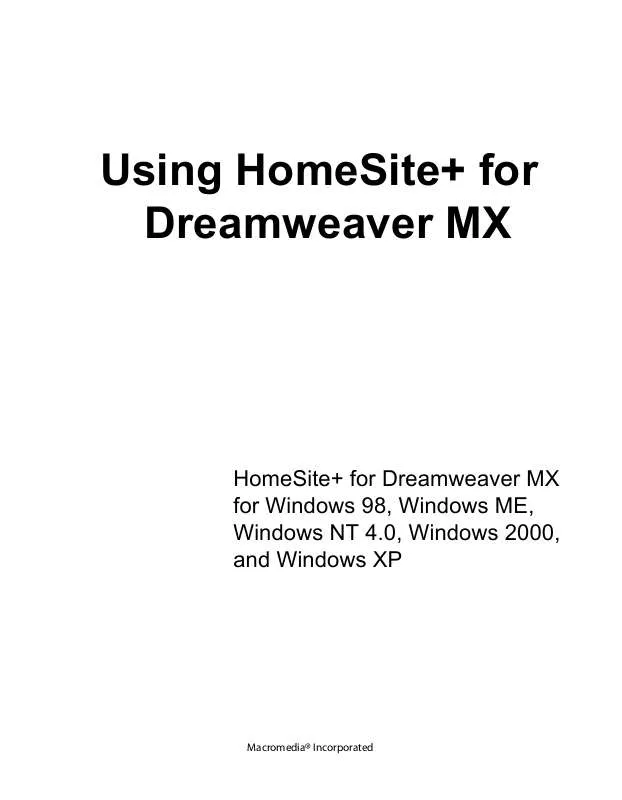Detailed instructions for use are in the User's Guide.
[. . . ] Using HomeSite+ for Dreamweaver MX
HomeSite+ for Dreamweaver MX for Windows 98, Windows ME, Windows NT 4. 0, Windows 2000, and Windows XP
Macromedia® Incorporated
Copyright Notice
Copyright 2002 Macromedia, Inc. Macromedia, the Macromedia logo, ColdFusion, Dreamweaver, Flash, HomeSite, JRun, Quick Tag Editor, Roundtrip, and what the web can be are trademarks or registered trademarks of Macromedia, Inc. which may be registered in the United States and internationally. Java and Solaris are trademarks of Sun Microsystems, Inc. [. . . ] · Validate each tag automatically after you enter it. To do this, open the Options > Settings > Validation pane, select Tag validation - validates the current tag when the ">" key is typed, and click Apply.
124
Chapter 7 Using Web Development Languages
The validator checks every tag as soon as you enter its closing bracket (>). It does not validate a tag whose closing bracket was entered automatically, for example by a tag editor or from a QuickBar toolbutton. If something is wrong in the tag, an error message appears in red in the status bar.
Using the CSE HTML Validator
If you have installed this HTML validation tool, you can run it from HomeSite+ for Dreamweaver MX. The CSE Validator supports multiple languages and contains other useful features. For more information, open the Options > Settings >Validation pane and click the CSE HTML Validator link to visit their website.
To use the CSE HTML Validator:
1 2 3 4 5 In the Options > Settings > Validation pane, select Use CSE HTML Validator when validating the entire document. Complete the CSE HTML Validator Pro Configuration Editor dialog box. For a description of each field on a tab, click Help. Complete the Validator Engine Options (Validator/Logging/Tools/Network) dialog box. For a description of each field on a tab, click Help. 6 7 (Optional) To visit their website, click the CSE HTML Validator link. When you are done, click Apply.
Working with tag definitions
125
Working with tag definitions
Every tag in HomeSite+ for Dreamweaver MX has a definition file, written in VTML, that specifies the valid attributes for the tag and the content and formatting of the tag editor for the tag. Tag definitions are the source of information for tag editors, Tag Insight, Tag Tips, and Tag Inspector. Following are the namespaces for the tag definitions that are installed with HomeSite+ for Dreamweaver MX: XHTML, HTML, CFML, VTML, JSP, Java, JRUN, WML, HDML, SMIL, IMFL, RTML, and Custom.
About namespace precedence
A version of a markup language (or namespace) can have a tag with the same name as a tag in another namespace. For example, both the JRun and Java namespaces contain a servlet tag. To avoid conflicts, the tag definitions for different namespaces are installed in different directories, in the \Extensions\TagDefs directory under the application root directory. When you use a tag editor or the Tag Inspector, or Tag Insight is enabled, HomeSite+ for Dreamweaver MX needs to know which tag definition to use. The list in the Options > Settings > Tag Definitions Library pane represents the order in which HomeSite+ for Dreamweaver MX searches the directories when looking for a tag definition. For example, if you enter <region> in a document, right-click it and choose Edit Tag, the SMIL tag editor appears, because no other directory contains a <region> tag. On the other hand, if you edit a <servlet> tag, either the Java or JRun version of the tag editor could appear. If JRun is higher on the namespace list than Java, then the program uses the JRun version of the servlet tag definition, without continuing its search to discover the Java version. The following are two ways to manually override these defaults while working in the Editor: · Enter the namespace and a colon (:) in the tag before the tag name; for example, enter <java:servlet>. [. . . ] For more information, see the W3C HyperText Markup Language Home Page at www. w3. org/ MarkUp/. Defines the structure of information, or how the information could be stored in a database. For example, an XML language for cooking could have a <recipe> tag, and <recipe> could contain tags for <header>, <ingredients>, and <instructions>. The power of XML lies in the fact that the
Glossary
329
information can be stored and retrieved from a database, rendered in a variety of formats, and used for a variety of purposes--for example on a Web page, hand-held computer, or cell phone; or for a cookbook, recipe card club, or book about cilantro.
330
Glossary
Index
A
ActiveDocument Object 258 ActiveScript configuring product for 101 examples in VTOM 304 ActiveX 101 advanced search operators 38 anchoring regular expressions to strings 111 answers, finding xviii APF files 140 Application Object 227 arguments, inserting with Tag Insight 56 ASP color coding for 112 support for 98 validating code with 121 attributes viewing 55 Auto Backup options 47 using 47 Auto Completion, about 57
removing 13 setting file saving behavior 13 viewing list of 12 building SQL statements 134
C
Cascading Style Sheets. [. . . ]


